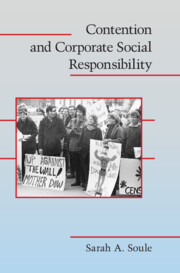Book contents
- Frontmatter
- Contents
- Figures
- Tables
- Preface
- 1 INTRODUCTION
- 2 UNDERSTANDING SOCIAL MOVEMENTS, CONTENTIOUS AND PRIVATE POLITICS, AND THEIR CONSEQUENCES
- 3 ANTICORPORATE PROTEST IN THE UNITED STATES, 1960–1990
- 4 THE EFFECT OF PROTEST ON UNIVERSITY DIVESTMENT
- 5 PRIVATE AND CONTENTIOUS POLITICS IN THE POST-1990 ERA
- 6 CONCLUSION
- Appendix A Description of Data Used in Chapter 3
- Appendix B Modeling Technique Used in Chapter 3
- Appendix C Sources of Data for Analysis in Chapter 4
- Appendix D Modeling Technique Used in Chapter 4
- Bibliography
- Index
4 - THE EFFECT OF PROTEST ON UNIVERSITY DIVESTMENT
Published online by Cambridge University Press: 05 June 2012
- Frontmatter
- Contents
- Figures
- Tables
- Preface
- 1 INTRODUCTION
- 2 UNDERSTANDING SOCIAL MOVEMENTS, CONTENTIOUS AND PRIVATE POLITICS, AND THEIR CONSEQUENCES
- 3 ANTICORPORATE PROTEST IN THE UNITED STATES, 1960–1990
- 4 THE EFFECT OF PROTEST ON UNIVERSITY DIVESTMENT
- 5 PRIVATE AND CONTENTIOUS POLITICS IN THE POST-1990 ERA
- 6 CONCLUSION
- Appendix A Description of Data Used in Chapter 3
- Appendix B Modeling Technique Used in Chapter 3
- Appendix C Sources of Data for Analysis in Chapter 4
- Appendix D Modeling Technique Used in Chapter 4
- Bibliography
- Index
Summary
During the late 1970s, in the wake of the Soweto Uprising of 1976, students in the United States began protesting, demonstrating, signing petitions, building blockades, staging sit-ins, building shantytowns, and participating in a movement designed to encourage pension funds, insurance companies, and other organizations to disinvest of their South African-related securities. This movement, known to most as the student divestment movement, had its roots in earlier student antiapartheid activism, which began after the Sharpeville Massacre of 1960, but fluctuated throughout the 1960s and 1970s. But, by the mid-1960s, student activists (many of whom were from seminaries in and around New York City and also from colleges in western Massachusetts), had organized a boycott against the First National City Bank (later Citibank) and Chase Manhattan, both of which ran branches in South Africa. The boycott was followed by demonstrations in March 1965 led by Students for a Democratic Society (SDS), Congress on Racial Equality (CORE), the Student Nonviolent Coordinating Committee (SNCC), and several other student and civil rights organizations outside of Chase Manhattan's downtown headquarters (Jones 1965). These events were joined by protest marches in the Spring of 1968 at Princeton, the University of Wisconsin, and Cornell, all of which explicitly called for banks and corporations to disinvest from South Africa (Massie 1997).
Thus, by the early 1970s, student antiapartheid activists had begun to reframe their goals from the very broad goal of ending apartheid, to the narrower goal of ending corporate investment in South Africa, to (eventually) the very specific goal of divestment by their own universities of holdings in corporations with ties to South Africa.
- Type
- Chapter
- Information
- Contention and Corporate Social Responsibility , pp. 80 - 103Publisher: Cambridge University PressPrint publication year: 2009



